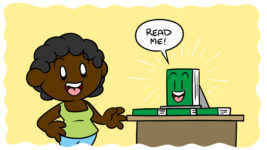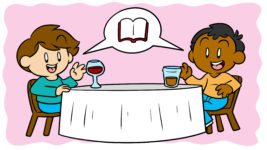You may think that, as an author, you can easily publish acclaimed work and gather a dependable readership without having to build any kind of brand. It’s a fantasy, but not in the way you might think.
It’s possible, though difficult, to attract an audience without building a deliberate brand, but once they arrive, they’re going to start forming ideas about who you are. No matter how much or how little effort you put into your public perception, they’ll use anything you publicly release – be it a novel or a blog post – to construct a persona. So, why not control the narrative?
If you don’t show your readers who you are, they’ll invent a persona for you.Click To TweetYou might be understandably skeptical of the idea. Words like ‘marketing’ and ‘branding’ always sound dirty to the ears of artists. But, branding doesn’t have to be forced, restrictive or hollow. What it should be is true, distinctive and appealing. Good branding suggests professionalism to your reader, and professionalism also means credibility, which will hopefully lead to investment in you and your work.
We’ve talked before about how and why a brand is so useful to professional writers, and explored the things you should consider when constructing your own. Once you have that brand, though, you need to be able to demonstrate it to your readers.
What is a ‘visual brand’?
A brand identity is how your audience perceives you. The common analogy used by marketing folk is to imagine this identity made real – to see it as if it were a person. Cheesy, I know, but it’s effective. That means that what you’re trying to do through your branding is make that person likable enough to attract friends (readers). By extension, visual branding is what that person looks like and what their appearance communicates to others. In other words, how you ‘dress’ your brand to appeal to a like-minded target audience.
Putting this extended metaphor to one side for a second, the look of your brand is achieved through a library of design tools – typography, images, colors, and layouts – all individual pieces that fit together to create one, cohesive picture.
So how do I begin?
Let’s break it down, step by step.
Step 1 – Identify your audience
Establish this using whatever parameters you feel are applicable – age, gender, location, tastes, job, education level, etc. If you’re finding it hard to pin down who your potential audience is, look at a competitor’s.
Step 2 – Identify your value
By this, I mean the unique thing that you as a writer can offer. What is your ideal reader looking for from a book? What gap in the market can you fill? How is your voice different?
Step 3 – Visualize your personality
This is more marketing jargon, meaning how you visually express your identity as an author. This can be tricky to conceptualize. In fact, it sounds almost like a riddle – how do you convey personality without being face-to-face with someone? The answer is through the library of design tools I mentioned earlier. After you’ve pinpointed your audience and identified your value, you’ll know what your readers are looking for and what your can offer them that’s different from anyone else. Your visual branding should illustrate this.
Compare the websites of two authors whose work couldn’t be more different – John Le Carre and Amy Krouse Rosenthal. What they have in common are beautifully designed sites brimming with personality. From font to color scheme, every element has been carefully considered to tell you a story before you even open one of their books.
Consistency, simplicity and repetition
Designers will preach to you that simplicity is key, and Haruki Murakami’s website certainly illustrates this. Simplicity means clarity in branding – a clearly and concisely communicated message for eyes that will be quickly distracted by something else popping up on their screen. Simplicity also helps you keep things consistent across every facet of your marketing – from your book covers to your Twitter profile. Make sure you’re keeping an accurate record of your brand’s chosen colors, fonts, shapes and layouts in your design library so you can ensure this.
A great visual brand has consistency, simplicity and repetition.Click To TweetConsistency means your brand’s visual message is accurately reinforced everywhere, and lends you an air of professionalism that will build up trust from your audience. This may sound difficult, but it also allows you to re-use visual assets over all your platforms, which will also save you money.
The cherry on top
Building a brand means building a complete package. Getting the fundamentals of visual branding down for your website is a bit like building a house, but once it’s built, you need to decorate and furnish it. You need some great content: blog posts, social media plug-ins, author updates and videos are all tried-and-tested methods you could use, but in all honesty, you should choose a method that works best for you, or else readers will spot the insincerity. If you love to blog, get typing; if you can’t stop chatting, host a podcast. In a pinch, of course, you could outsource these jobs.
For ideas on really distinctive and creative tactics that help to reinforce your visual brand, take a look at these case studies.
Stephenie Meyer
“One of us” – building empathy
‘Relatability’ is one of those advertising terms that will forever elicit eye-rolling whenever it’s used. Ironically, we often associate it with cheesy phoniness, but I’m going to expose one of my guiltiest pleasures to prove to you that it really can work.
As we get older, we often look for things that challenge us, but when we’re younger and more impressionable, we usually seek things that conform to our points of view instead. We’re looking for identity confirmation. We’re looking for people who are like us. Before the movie adaptations helped to cement Meyer’s vampire romance novels as a cultural phenomenon, word of the books was spread – not through a targeted, mass media campaign – but by digital word of mouth. Before I even knew their names, fan art and fiction about Bella and Edward were flooding my old web haunts as a teenager. Curious, I headed to Meyer’s website, which at the time was styled monochromatically with splashes of red to echo the book covers (the styling changes with each new series release) and discovered that she’d shared a playlist of music she’d listened to when writing the first book. And it was filled with bands I knew, and even liked.
Make your website a space in which your ideal reader feels at home.Click To TweetAfter seeing that – and already being a graduate of Buffy the Vampire Slayer and Anne Rice – I was certain the books would be for me. After all, Meyer was clearly one of ‘us’ – her website looked like the kind of place I belonged. For a younger audience, that sense of kinship is powerful branding. It clearly works for her, too, as it’s a strategy she employs to this day. Being on the same wavelength as your audience can sometimes seem like a happy accident, but really, you should already be a fan of the genre you write in, so it shouldn’t be too difficult to think the same way your audience does and create the kind of content that they can empathize with.
Lemony Snicket
Method acting – building a character
Many authors use pen names, and for lots of reasons. The Victorian writer Mary Ann Evans infamously wrote under the male name ‘George Eliot’ so that she could be taken more seriously in a time when sexism was more pronounced. Even today, both male and female authors choose to write under gender-swapped pseudonyms to shake off gendered stereotypes. Some also do it to strategically disassociate from their brand, in order to create another, like J.K Rowling branching out into adult crime fiction as ‘Robert Galbraith’. However, very few have quite as heavily committed to their alter egos as Daniel Handler, better known as children’s author ‘Lemony Snicket’.
As Snicket, Handler added an entirely new dimension to his A Series of Unfortunate Events books by integrating the author into the story. It’s a mask that rarely slips, from his in-character prefaces to each book, to author photos that never show his face, to the profile on his website, to the wonderfully stylized Netflix adaptation that he helped contribute scripts to, in which the Snicket (not Handler) appears – ever present – to address his melancholic narration directly at the audience from within a scene. The Unfortunate Events books are all about deep and absurd conspiracies and oddball characters with mysterious identities, so Handler/Snicket’s role completely reinforces the brand.
Establishing a visual brand of mystery and conspiracy across every platform also means that, wherever readers go looking for him, their sense of his persona is the same – this isn’t something that only exists within the books, but a cohesive decision that invites and withstands reader investigation.
How do I introduce my visual brand?
Where you begin your branding will depend on your genre, style and resources, but it’s useful to start in one place and then build out. Your book’s cover is often an effective starting point – it has definite things to say about your work, and it’s better to let it set the tone than make it answerable to other elements. If you don’t yet have a cover, try starting with your author photo. This should establish a preferable color palette, which you can use to expand out into web pages and word art. Once you know what color your words will be (in webpage and social media headers, for example), you’re in a good place to pick appropriate fonts, and you can work out from there.
If you’re making a choice – even a small one – then consider your visual brand.Click To TweetSome things go without saying – serious subjects benefit from muted tones, while brighter subjects mean brighter colors – but you can go deeper. Edges, for example, subconsciously suggest conflict, so even the shapes you choose to associate with your brand matter. A good rule of thumb is to be aware of decisions; every time you choose something, consciously check how it can fit into your visual brand. It may seem inconsequential, but if it’s a ‘choice’, if there were other options to consider, then there’s the potential to fold in some vital meaning.
A good book deserves good visual branding
Worrying about the visual elements of your marketing as a literary creator may seem unnecessary or foreign, but it’s virtually impossible nowadays to avoid having some kind of presence and be a commercial artist. Even the fame-shy Sia has had to build her preference for anonymity into her brand. Ultimately, a strongly written book deserves strong visual branding, as does the author who wrote it.
For more on how to use visual branding effectively, check out Why Images Should Be Part Of Your Book Marketing Strategy and Is There Such A Thing As A Good Book Trailer? Or, for a wider overview, try Why You Need To Brand Yourself As An Author, And Exactly How To Do It. Have you made any hard choices in the name of visual branding? Let me know in the comments.





